
Salvador Dali The Sick Child. Self-Portrait in Cadaqués 1921

Strawberry Fields Forever – John Lennon (Vocals Only)
Strawberry Fields Forever – John Lennon (Vocals Only) pic.twitter.com/nts9k7Lrdi
— The Beatles (@BeatlesEarth) December 7, 2020

Are we going to give these vaccines an honest look?
• China’s Sinovac To Double COVID19 Vaccine Output (F.)
Anticipating regulatory approval off the back of ongoing clinical trials, China’s Sinovac Biotech said it has received more than $500 million from investors to help it ramp up production and distribution capacities for its leading Covid-19 vaccine candidate, CoronaVac. Sino Biopharmaceutical, which is listed in Hong Kong, invested $515 million in Sinovac in exchange for a roughly 15% stake in the part of the company responsible for CoronaVac manufacture. The investment will help the company boost vaccine production, which it hopes will double to 600 million doses annually — roughly enough for 300 million people — upon the completion of a second production facility in late 2020.
In addition to funding CoronaVac, CEO Weidong Yin says the partnership will enable Sinovac to “improve our vaccine sales capabilities, expand in Asia markets, develop and access new technologies, and most importantly, accelerate our efforts to help combat the global pandemic.” CoronaVac is one of China’s leading hopes for a safe and effective domestic vaccine. Its development is under a great deal of pressure — as a matter of national pride, as a means of safeguarding Chinese citizens from Covid-19 and because Beijing has promised a great deal of it to less-affluent countries — something the recent successes of not one but three western vaccines will intensify. Its success will mean a lot globally, as it does not require the onerous ultra-cold storage requirements that Pfizer and Moderna’s vaccines do, making it much more accessible in poorer regions.
Early trial data is promising, though larger Phase 3 clinical trials have yet to be conducted, with approval already either granted or close to being granted in Brazil, Indonesia, Turkey and Chile. “We have made significant progress in the development of our COVID-19 vaccine candidate CoronaVac, which has reached critical milestones in clinical trials in Asia and Latin America,” said Weidong Yin. 600 million. That’s how many doses of CoronaVac Sinovac hopes to produce a year once its new production facility is up and running. Blaming supply chain issues, Pfizer and BioNTech halved their estimated vaccine output for 2020, saying they will now only deliver 50 million of a promised 100 million doses.

“That a vaccine was available for the entire brutal duration may be, to future generations trying to draw lessons from our death and suffering, the most tragic, and ironic, feature of this plague.”
• We Had the Vaccine the Whole Time (NYMag)
You may be surprised to learn that of the trio of long-awaited coronavirus vaccines, the most promising, Moderna’s mRNA-1273, which reported a 94.5 percent efficacy rate on November 16, had been designed by January 13. This was just two days after the genetic sequence had been made public in an act of scientific and humanitarian generosity that resulted in China’s Yong-Zhen Zhang’s being temporarily forced out of his lab. In Massachusetts, the Moderna vaccine design took all of one weekend. It was completed before China had even acknowledged that the disease could be transmitted from human to human, more than a week before the first confirmed coronavirus case in the United States. By the time the first American death was announced a month later, the vaccine had already been manufactured and shipped to the National Institutes of Health for the beginning of its Phase I clinical trial.
This is — as the country and the world are rightly celebrating — the fastest timeline of development in the history of vaccines. It also means that for the entire span of the pandemic in this country, which has already killed more than 250,000 Americans, we had the tools we needed to prevent it . To be clear, I don’t want to suggest that Moderna should have been allowed to roll out its vaccine in February or even in May, when interim results from its Phase I trial demonstrated its basic safety. “That would be like saying we put a man on the moon and then asking the very same day, ‘What about going to Mars?'” says Nicholas Christakis, who directs Yale’s Human Nature Lab and whose new book, Apollo’s Arrow, sketches the way COVID-19 may shape our near-term future. Moderna’s speed was “astonishing,” Christakis says, though the design of other vaccines was nearly as fast: BioNTech with Pfizer, Johnson & Johnson, AstraZeneca.
Could things have moved faster from design to deployment? Given the grim prospects for winter, it is tempting to wonder. Perhaps, in the future, we will. But given existing vaccine infrastructure, probably not. Already, as Baylor’s Peter Hotez pointed out to me, “Operation Warp Speed” meant running clinical trials simultaneously rather than sequentially, manufacturing the vaccine at the same time, and authorizing the vaccine under “emergency use” in December based only on preliminary data that doesn’t track the long-term durability of protection or even measure the vaccine’s effect on transmission (only how much it protects against disease). And as Georgetown virologist Angela Rasmussen told me, the name itself may have needlessly risked the trust of Americans already concerned about the safety of this, or any, vaccine.
Indeed, it would have been difficult in May to find a single credentialed epidemiologist, vaccine researcher, or public-health official recommending a rapid vaccine rollout — though, it’s worth noting, as early as July the MIT Technology Review reported that a group of 70 scientists in the orbit of Harvard and MIT, including “celebrity geneticist” George Church, were taking a totally DIY nasal-spray vaccine, never even intended to be tested, and developed by a personal genomics entrepreneur named Preston Estep (also the author of a self-help-slash-life-extension book called The Mindspan Diet). China began administering a vaccine to its military in June. Russia approved its version in August.
And while most American scientists worried about the speed of those rollouts, and the risks they implied, our approach to the pandemic here raises questions, too, about the strange, complicated, often contradictory ways we approach matters of risk and uncertainty during a pandemic — and how, perhaps, we might think about doing things differently next time. That a vaccine was available for the entire brutal duration may be, to future generations trying to draw lessons from our death and suffering, the most tragic, and ironic, feature of this plague.

Vilsack’s nickname is “Mr. Monsanto”.
• Vilsack Emerges As Biden’s Top Choice For USDA (Pol.)
President-elect Joe Biden is leaning toward picking former Agriculture Secretary Tom Vilsack to return as head of the USDA, according to four people familiar with the discussions, turning to a longtime ally over several other more diverse candidates who have been jockeying for the role. Though the decision is not final and the dynamics are still in flux, Vilsack’s emergence as the strong favorite for the job indicates the transition is looking for a USDA leader with deep management and policy experience who is close with the Biden-world. The former Iowa governor, who served as Agriculture secretary for eight years under the Obama administration, was a top rural and agriculture policy adviser to the Biden campaign. “He is the preferred choice of Biden’s inner circle,” one of the people said, but added, “that could change.”
The new frontrunner status for Vilsack comes after weeks in which the public discussion largely centered on former North Dakota Sen. Heidi Heitkamp and Ohio Rep. Marcia Fudge, who has a vocal set of allies lobbying for her to get the position. Biden was on the verge of tapping Heitkamp for the role as recently as two weeks ago, POLITICO reported last week. But those plans were scrambled after House Majority Whip Jim Clyburn publicly criticized the transition team for a lack of diversity among its Cabinet picks to date. Clyburn has been encouraging Biden to select Fudge for Agriculture secretary. While Vilsack leads the short list, new potential names for the role continue to pop up, like former Michigan attorney general and Gov. Jennifer Granholm.

And this guys sits on the board of top arms producer Raytheon. How crazy are we going to make this?
• Biden Picks Retired General Lloyd Austin To Run Pentagon (Pol.)
President-elect Joe Biden has selected Retired Gen. Lloyd Austin to serve as secretary of defense, according to three people with knowledge of the decision. If confirmed, Austin would be the first Black person to lead the Pentagon. In picking Austin, Biden has chosen a barrier-breaking former four-star officer who was the first Black general to command an Army division in combat and the first to oversee an entire theater of operations. Austin’s announcement could come as soon as Tuesday morning, people familiar with the plans said Monday. Austin, who also ran U.S. Central Command before retiring in 2016, emerged as a top-tier candidate in recent days after initially being viewed as a longshot for the job.
Michèle Flournoy, Obama’s former Pentagon policy chief, was initially viewed as the frontrunner, but her name was notably absent from Biden’s rollout of key members of his national security team two weeks ago. Biden had been under growing pressure to nominate a Black person to be his defense secretary in recent weeks. He chose Austin after also considering former Homeland Security Secretary Jeh Johnson for the job, several people familiar with the discussions said. Lingering concerns about Johnson’s tenure in the Obama administration improved Austin’s standing among Congressional Black Caucus members in recent days, according to two people, including a House Democratic aide. Johnson has been criticized for his record on expanding family detention and accelerating deportations, as well as approving hundreds of drone strikes against suspected terrorists that killed civilians.


“When their corpses arrived back in the U.S., Obama hailed the victims for embodying “the courage, the hope, and yes, the idealism, that fundamental American belief that we can leave this world a little better than before.”
• Barack Obama & the Death of Idealism (Bovard)
Shortly before his first inauguration, Obama announced, “What is required is the same perseverance and idealism that our founders displayed.” After Obama’s inaugural address, the media rejoiced as if a new age of political idealism had arrived. Practically the entire world joined the race to canonize the new president. Less than 12 days after he took office, Obama was nominated for a Nobel Peace Prize — which he received later that year. Indian Prime Minister Manmohan Singh declared at a White House state dinner, “We warmly applaud the recognition by the Nobel Committee of the healing touch you have provided and the power of your idealism and your vision.” Shortly after receiving the Peace Prize, Obama announced he would triple the number of U.S. troops in Afghanistan. The Peace Prize helped insulate him from criticism as he proceeded to bomb seven nations during his presidency.
Obama-style idealism quickly became a shroud for federal atrocities. On Holocaust Remembrance Day on April 23, 2009, Obama called for “fighting the silence that is evil’s greatest co-conspirator.” Ironically, on the same day, Obama decided to oppose creation of a truth commission to vigorously investigate and expose Bush administration crimes. After Obama visited CIA headquarters and praised his audience for helping to “to uphold our values and ideals,” Obama chose not to prosecute any CIA officials who created a secret worldwide torture regime because “it’s important to look forward and not backwards.” Over the next five years, Obama administration officials vigorously fought a Senate investigation into Bush torture abuses, and Obama personally defended the CIA after it was caught illegally spying on the Senate to thwart the inquiry.
The Obama administration also torpedoed every lawsuit by a torture victim in U.S. court. In 2011, Obama draped his decision to bomb Libya by invoking “democratic values” and the “ideals” which he asserted were “the true measure of American leadership.” But terrorist groups fighting dictator Muammar Qaddafi were already slaughtering civilians. Obama was so convinced of the righteousness of targeting Qadaffi that his appointees signaled that federal law (such as the War Powers Act) could not constrain his salvation mission. In the chaos that subsequently engulfed Libya, ambassador Christopher Stevens and three other Americans were killed during an attack on the U.S. consulate in Benghazi. When their corpses arrived back in the U.S., Obama hailed the victims for embodying “the courage, the hope, and yes, the idealism, that fundamental American belief that we can leave this world a little better than before.”
Obama’s soothing rhetoric failed to deter the proliferation of slave markets where black migrants were openly sold in Libya. Obama declared that America’s “ideals still light the world, and we will not give them up for expedience sake” in his first inaugural address. But one of Obama’s most shocking legacies was his claim of a prerogative to kill U.S. citizens labeled as terrorist suspects without trial, without notice, and without any chance for the marked individuals to legally object. Obama’s lawyers even refused to disclose the standards used for designating Americans for death. Drone strikes increased tenfold under Obama, and he personally chose who would be killed at weekly “Terror Tuesday” White House meetings which featured PowerPoint parades of potential targets.

EO 13848 : A Trump Trojan Horse?
• A Resolving Picture (Kunstler)
An awful lot has been churning in the deep background for months before the election. Mr. Trump was onto the mass write-in vote scam enabled by the media-assisted hysteria over Covid-19. The wheels of genuine US intel against national security threats still turned in spite of whatever Deep State perfidy had been aimed at Mr. Trump himself from Day One in office, and the president made use of his own private counter-intel hackers to suss out the game — which was finally to overthrow him by ballot fraud. The result was Executive Order 13848 issued in September 2020, which specified foreign interference in elections as “an unusual and extraordinary threat to national security” and laid out some pretty stringent remedies.
The main one was a requirement for the top executive agencies — DOJ, DOD, Homeland Security, Treasury plus the Director of National Intelligence (Mr. Ratcliffe) — to deliver an assessment within 45 days of the election. We’re now in the sweet-spot of that 45-day delivery period when something has to pop. Looks a little like the AG, Mr. Barr, has been dithering and wriggling painfully over this, and even making noises about resigning. But he may have already surrendered his credibility, with the foot-dragging of the FBI under Christopher Wray and the agency’s apparent lack of interest in election fraud. The consequences of EO 13848 will roll out with him or without him.
The real action was over at the Department of Defense, where the President hastily cleaned house this fall and installed the trustworthy Christopher Miller as SecDef, along with top aide Kash Patel and Ezra Cohen-Watnick as Acting Under Secretary of Defense for Intelligence and Security. Mr. Cohen-Watnick had been an assistant to General Michael Flynn, former Director of Defense Intelligence, in his brief tenure as National Security Advisor before getting sandbagged by Barack Obama and James Comey. Both Mr. Cohen-Watnick and General Flynn are intimately familiar with the apparatus of Defense Intelligence, of course, and have been actively using it to identify DNC and Joe Biden activists who played a role in election irregularities as well as foreign actors.
This wasn’t any RussiaGate type bullshit; it was the real deal. EO 13848 includes this provision: “The report shall identify any material issues of fact with respect to these matters that the Attorney General and the Secretary of Homeland Security are unable to evaluate or reach agreement on at the time the report is submitted. The report shall also include updates and recommendations, when appropriate, regarding remedial actions to be taken by the United States Government, other than the sanctions described in sections 2 and 3 of this order.”
The “remedial actions” are interesting. They include pretty severe sanctions against any “persons” (entity or company) involved in or enabling foreign interference in elections: attaching property in the US, blocking trade, and an array of financial restrictions and penalties. The EO does not spell out criminal penalties that might fall under the sedition and treason statutes, but expect these to be activated as the law provides. Quite a few political celebrities and figures in the news and social media may have exposed themselves to liability in this. If it doesn’t mean the end of Facebook or Twitter, it may spell the end of Mark Zuckerberg and Jack Dorsey running them. Also include the less-well-known execs at The WashPo, The New York Times, and several cable news networks.

Who’s going to fund the lower levels of government?
• What’s Ahead for New York? Maybe a Budget ‘Nightmare Scenario’ (NYMag)
Over the summer, Mayor Bill de Blasio made a virtual pilgrimage to testify before an antique government body , the New York State Financial Control Board. Created decades ago, in the depths of the 1970s fiscal crisis, the control board once dominated the city’s government with a tight fist. Today, to the extent it is remembered at all, it is widely presumed to be defunct. But the entity still exists in a dormant state, like Godzilla sleeping at the bottom of the ocean. The control board now typically convenes just once a year, for a simple review of the city’s finances. It is usually a perfunctory ritual, but this August’s meeting was different. Governor Andrew Cuomo, in a move that caused a ripple of municipal intrigue, had just appointed three new members to the board, including a trusted former top aide, and there were rumblings that the monster was stirring.
Cuomo’s budget director, Robert Mujica, opened the Zoom with dire deficit projections. “Today, as a result of the global pandemic, the city’s financial position and the city itself faces perhaps its most severe crisis since 1975,” he said. “And it may actually be worse than that.” De Blasio spoke next, departing from his prepared remarks to offer a rebuttal. “The study of history teaches you what is the same and what is different,” the mayor said. “I think it would just be a mistake to think this is anything like the New York City of the ’60s or ’70s, or even ’80s … even though we’ve been obviously deeply thrown for a loop.” What the two men were arguing about, besides the usual city-versus-state power struggle, was a question that will continue to hang over the city for months — maybe years — to come: How bad is the damage?
Viewed from the mayor’s perspective, the pandemic, as terrible as it has been, is a temporary disaster that should begin to resolve itself with the imminent approval of a vaccine, allowing New York’s economy to return to its previous healthy state. (The city government ran a $4.2 billion surplus as recently as last year.) But to fiscal pessimists, the glass is not just half-empty — it’s shattered. The city is now projected to face a $13.2 billion budget gap over the next four years. And so far, its government has made little tangible effort to address the shortfall. “What we’ve learned,” Andrew Rein, president of the nonpartisan Citizens Budget Commission, said after the city released revised revenue and spending estimates last week, “is that we’re actually still doing nothing about a fiscal crisis.”
For the moment, discussions of what budgetary pain may come after the pandemic have been muted, overwhelmed by a cascade of more immediate developments, including the election, the transition to the Biden administration, a new wave of COVID cases, and the heartening prospect of mass vaccination. This week, there has been a flurry of activity in Washington, with a potential breakthrough in negotiations over a proposed $900 billion stimulus package. But even if it comes, it would be a stopgap. Eventually, a reckoning will have to come.

Shouldn’t there be more questions about QE? Right now, there are hardly any left at all.
• Swedish Central Bank Governor Slams Expansion Of QE (ZH)
Two weeks ago, the oldest central bank in the world, Sweden’s Riksbank stunned the world when it unveiled 40% more QE than consensus had been expecting. Specifically, the Riksbank announced that it was expanding its quantitative easing program to 700 billion kronor ($82 billion), which was 200 billion kronor more than its earlier target. To be sure, with the Riksbank having locked itself in after Governor Stefan Ingves said just a few years prior that its “experiment” with negative rates was officially over, expanding QE was the only available option unless the central bank was willing to gamble with its credibility (and until there is a far greater crisis when negative rates will be unavoidable, damn the soaring house prices).
And while most Swedish central bankers were on board with the decision, there was at least one who hopefully sees the writing on the wall: that central banks will be able to superglue the falling house of cards for only a few more years (effectively echoing the BIS’ latest warning). In a jarring break with the central bank consensus, Riksbank Deputy Governor Martin Floden presented a “long list of objections to the proposed decision” to expand QE through to the end of 2021, he said in minutes from the Nov 25 policy discussion, and noting that “it is the list as a whole that leads me to enter a reservation.” Below we summarize his six objections:
• First, it’s unlikely that further purchases will be able to push down already low bond yields to noticeably lower levels, and that ” a promise today for larger asset purchases will not make monetary policy more expansionary in the near term.”
• Second, it’s “uncertain whether asset purchases in the autumn of 2021 will make monetary policy more expansionary then.”
• Third, “communication concerning a comprehensive purchasing program until the end of 2021 may generate more uncertainty than clarity”
• Fourth, “the actors and markets” that the Riksbank can directly affect are still not in such an acute crisis situation as they were in the spring
• Fifth, “the most important mechanism is that central banks, via asset purchases, are able to remove risk from the markets.” And since this mechanism hardly works if the Riksbank purchases government securities with short maturities, Floden doesn’t consider purchases of treasury bills to be an effective measure
• Sixth, uncertainty over developments in the near term is high, bank needs “to take a new monetary policy decision to purchase more in the near term”
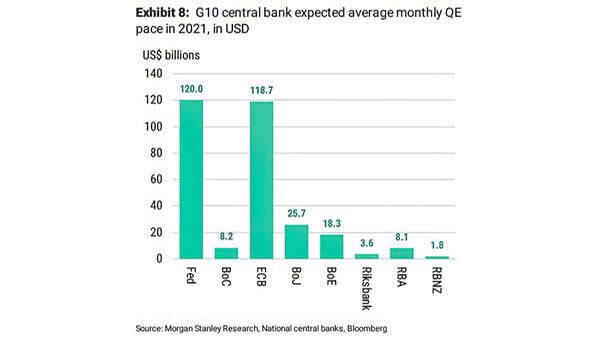

Dress it in green, you get away with anything.
• Japan Unveils $708 Billion In Fresh Stimulus With Eye On Post-COVID Growth (R.)
Japan announced a fresh $708 billion economic stimulus package on Tuesday to speed up the recovery from the country’s deep coronavirus-driven slump, while targeting investment in new growth areas such as green and digital innovation. The new package will include about 40 trillion yen ($384.54 billion) in direct fiscal spending and initiatives targeted at reducing carbon emissions and boosting adoption of digital technology, Prime Minister Yoshihide Suga said in a meeting with ruling party executives. Policymakers globally have unleashed a wall of monetary and fiscal stimulus to prevent a deep and prolonged recession as the coronavirus closed international borders and sent millions out of work.
In the United States, a $908 billion coronavirus aid plan is currently under debate in Congress. In Japan, the pandemic has forced the government to put its fiscal reform agenda on the backburner, despite holding the industrial world’s heaviest public debt burden, which is twice the size of its gross domestic product. “We have compiled the new measures to maintain employment, sustain business and restore the economy and open a way to achieve new growth in green and digital areas, so as to protect people’s lives and livelihoods,” Suga said at the meeting. Suga’s cabinet is set to endorse the stimulus package later on Tuesday, which would bring the combined value of coronavirus-related stimulus to about $3 trillion.

70% of US GDP is consumers.
• US Credit Card Balances in Steepest Drop Ever (WS)
American consumers – let’s face it, consuming is the number one top job during these trying times – have paid down their credit cards again. In October, credit card balances and other revolving credit ticked down again from the prior month, and plunged by 10.3% from October last year, the steepest year-over-year drop ever, eking past the peak year-over-year drop during the Financial Crisis (-9.9% in January and February 2010):
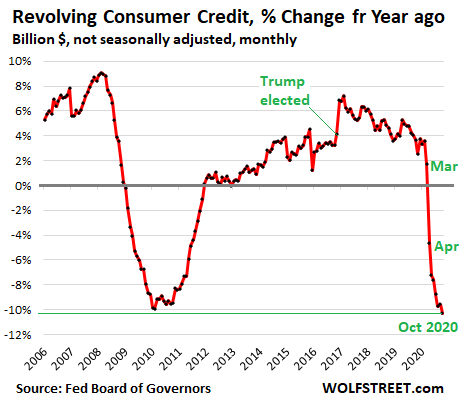
On a seasonally adjusted basis, credit card balances and other revolving credit declined to $980 billion (green line in the chart below), according to Federal Reserve data this afternoon – a balance first seen in October 2007, despite 13 years of inflation and population growth. Not-seasonally adjusted, credit card balances and other revolving credit ticked down to $943 billion (red line), a balance first seen in August 2007. Since the peak in December last year, balances have plunged by $151 billion. And this is something we have seen in other data: The seasonal adjustments can no longer adequately grapple with the new borrowing patterns that defy seasonality. The classic seasonality in consumer borrowing, established over many decades and utterly predictable, has been obviated by events:
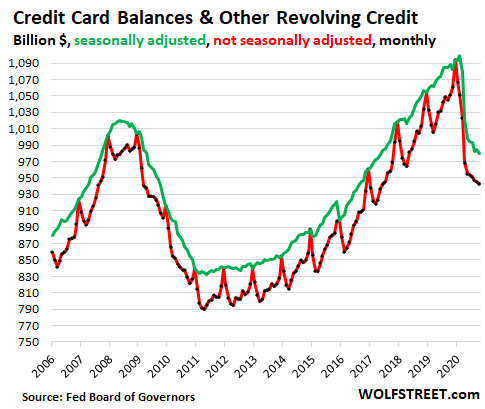
The mega-plunge in credit card balances in April was a result of the dual impact of stimulus payments that were applied to credit card balances and the lack of spending opportunities when big parts of the economy, where consumers normally use their credit cards to spend money, shut down, such as malls, restaurants, cruises, plane travels, and hotels. Before the Financial Crisis, there had never been a year-over-year decline in revolving credit. For decades, Americans had been in the mode of piling on credit card debt with astounding passion and double-digit year-over-year surges in the early years, which allowed them to buy things and do things that they couldn’t otherwise afford, and it cranked up the US economy. The scheme lasted until the blowup during the Financial Crisis that caused the first-ever year-over-year decline. Now there’s the second year-over-year decline, and the steepest ever:
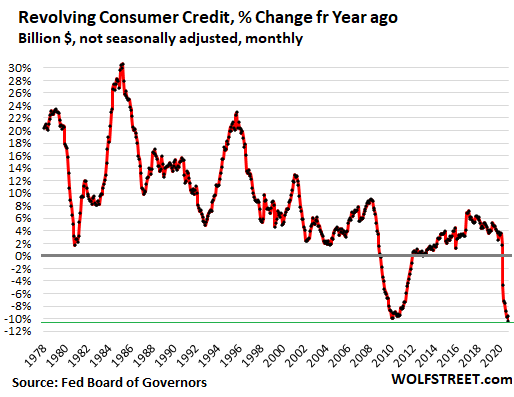

Not quite sure where this came from.
• Tucker Carlson: Our Elites’ Collusion With China Is Real And Widespread (Fox)
On Nov. 28, Di Dongsheng, a professor at Renmin University in Beijing, appeared on a Chinese television show about Wall Street and international trade. Like so many in academia in China, Di is a servant of his country’s government. This video was deleted from Chinese social media soon after being uploaded, and here’s why: DI DONSHENG (translation): The Trump administration is in a trade war with us, so why can’t we fix the Trump administration? Why, between 1992 and 2016, did China and the U.S., use to be able to settle all kinds of issues? No mater what kind of crises we encountered … things were solved in no time … We fixed everything in two months. What is the reason? I’m going to throw out something maybe a little bit explosive here. It’s just because we have people at the top. At the top of America’s core inner circle of power and influence, we have our old friends.
[..] “We have people at the top. At the top of America’s core inner circle of power and influence.” According to Di Dongsheng, that has been true for decades. So who are these people and how many of them work in our media and in our government? Well, Di didn’t say precisely. At another point in the program, he described a Chinese agent working as a vice president at, “a top Wall Street financial institution.” Di explained that he couldn’t say more without making political trouble. Di did tell his audience that one agent in particular was especially useful, and he goes on at some length about her. He describes her as an American who’s lived abroad for many years and is now a Chinese citizen, and this seems to baffle him a little bit. The Chinese government doesn’t allow dual citizenship. Why would they? Why would anyone?
Di seems pleased that the U.S. government is foolish enough to allow it. He explains that this American agent, who lives at least part of the year in Beijing, helped the Chinese government with a propaganda operation in Washington in 2015, and he goes on to describe that in some detail. The Obama administration was easy to manipulate, Di suggests. The Chinese had many friends among the Obama people. The problem came when Donald Trump was elected. After that, he says, everything changed.
DI DONGSHENG (translation): For the past 30 years, 40 years, we have been utilizing the core power of the United States … Since the 1970s, Wall Street had a very strong influence on the domestic and foreign affairs of the United States, so we had a channel to rely on. But the problem is that after 2008, the status of Wall Street has declined, and more importantly, after 2016, Wall Street can’t fix Trump. Why? It’s very awkward. Trump had a previous soft default issue with Wall Street, so there was a conflict between them. But I won’t go into details, I may not have enough time. So during the U.S.-China trade war they [Wall Street] tried to help. And I know that, my friends on the U.S. side told me that they tried to help, but they couldn’t do much.

And then Axios joins Fox?
• Suspected Chinese Spy Targeted California Politicians (Axios)
A suspected Chinese intelligence operative developed extensive ties with local and national politicians, including a U.S. congressman, in what U.S. officials believe was a political intelligence operation run by China’s main civilian spy agency between 2011 and 2015, Axios found in a yearlong investigation. The alleged operation offers a rare window into how Beijing has tried to gain access to and influence U.S. political circles. While this suspected operative’s activities appear to have ended during the Obama administration, concerns about Beijing’s influence operations have spanned President Trump’s time in office and will continue to be a core focus for U.S. counterintelligence during the Biden administration.
The woman at the center of the operation, a Chinese national named Fang Fang or Christine Fang, targeted up-and-coming local politicians in the Bay Area and across the country who had the potential to make it big on the national stage. Through campaign fundraising, extensive networking, personal charisma, and romantic or sexual relationships with at least two Midwestern mayors, Fang was able to gain proximity to political power, according to current and former U.S. intelligence officials and one former elected official. Even though U.S. officials do not believe Fang received or passed on classified information, the case “was a big deal, because there were some really, really sensitive people that were caught up” in the intelligence network, a current senior U.S. intelligence official said.
Private but unclassified information about government officials — such as their habits, preferences, schedules, social networks, and even rumors about them — is a form of political intelligence. Collecting such information is a key part of what foreign intelligence agencies do Among the most significant targets of Fang’s efforts was Rep. Eric Swalwell (D-Calif.). Fang took part in fundraising activity for Swalwell’s 2014 re-election campaign, according to a Bay Area political operative and a current U.S. intelligence official. Swalwell’s office was directly aware of these activities on its behalf, the political operative said. That same political operative, who witnessed Fang fundraising on Swalwell’s behalf, found no evidence of illegal contributions.

“She’s our hero. She helped boost sales tremendously.”
• AOC Called For Boycott, Sales Jumped, Goya Named Her Employee Of The Month (DW)
Goya Foods and president CEO Bob Unanue revealed that after Rep. Alexandria Cortez (D-NY) echoed a call for a boycott of Goya products back in July because Unanue supported President Trump, his company named her “Employee of the Month” because sales rose so dramatically. Unanue had visited the White House, where he stated, “We’re all truly blessed at the same time to have a leader like President Trump, who is a builder.” That prompted Julian Castro, former Housing and Urban Development secretary in the Obama administration, to tweet that Goya Foods “has been a staple of so many Latino households for generations. Now their CEO, Bob Unanue, is praising a president who villainizes and maliciously attacks Latinos for political gain. Americans should think twice before buying their products.”
Unanue was interviewed on The Michael Berry Show, where Berry commented: “When you see the radical plans like the Green New Deal, when you hear politicians like AOC spouting these things off, agriculture is a major employer in this country but it’s also a major consumer of energy, as you noted earlier. It’s an intensive process for labor and energy. And they are talking about things that would drive the cost of energy through the roof in some cases making it prohibitive for marginal players. How much does that concern you and how much do you feel the need to step up and say, “Hey, guys, you want me to lay off these thousands of employees because that’s what would have to happen?”
Unanue replied: “You know, communism works until you run out of other people’s money to spend. We’re not going to be able to do that. It’s interesting that AOC was one of the first people to step in line to boycott Goya; go against her own people, as supposedly a Puerto Rican woman, to go against people of her own Latin culture. She’s naïve. To some extent I can understand AOC; she’s young; she’s naïve; she doesn’t get it. But you’ve got someone like (Bernie) Sanders, who’s older than us, older than me, and he still doesn’t get it.” “We still have to chat with AOC; I love her,” Unanue continued.
“She was actually our Employee of the Month; I don’t know if you know about this, but when she boycotted us, our sales actually increased 1,000%. So we gave her an honorary — we never were able to hand it to her but she got Employee of the Month for bringing attention to GOYA and our adobo. Actually our sales of adobo did very well after she said ‘Make your own Adobo.’” Berry wondered, “Was it P.T. Barnum who said, ‘Say what you want just spell my name right. All publicity is good publicity.” Unanue replied, “She’s our hero. She helped boost sales tremendously.”

We try to run the Automatic Earth on donations. Since ad revenue has collapsed, you are now not just a reader, but an integral part of the process that builds this site.
Click at the top of the sidebars for Paypal and Patreon donations. Thank you for your support.

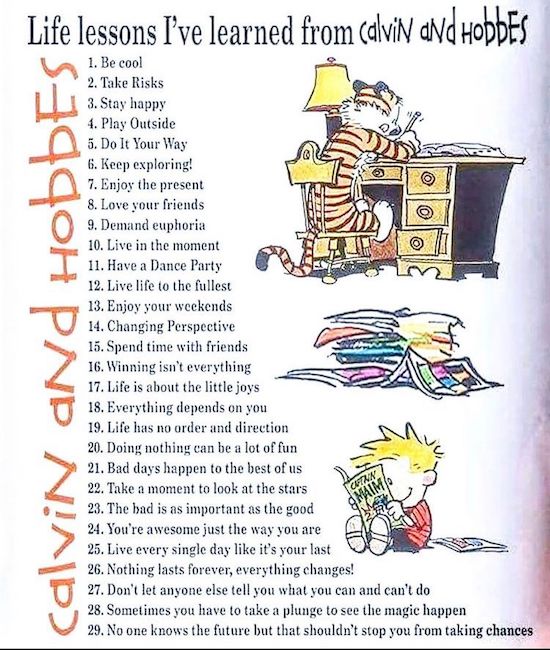

Support the Automatic Earth in virustime, election time, all the time. Click at the top of the sidebars to donate with Paypal and Patreon.







